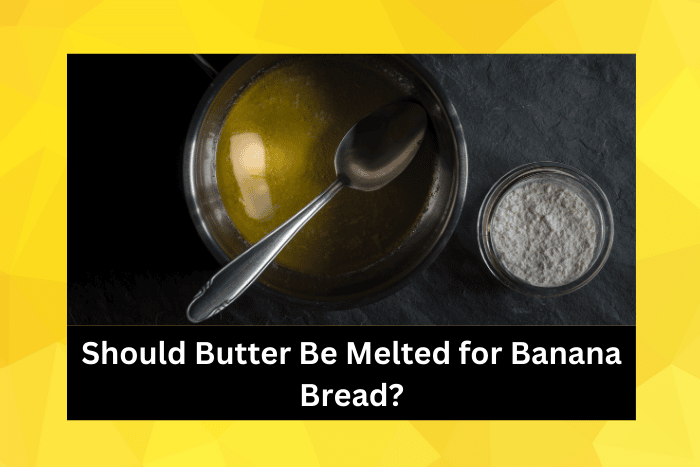It’s a question I see asked fairly often, should butter be melted for banana bread?
You’ll generally want to follow a specific recipe to the precise detail in order to produce the ideal final result.
And banana bread is certainly no different.
However, you may have noticed that some banana bread recipes call for melted butter, whereas others require softened butter.
So, which one should you be using?
Allow me to reveal what you need to know about banana bread and melted butter.
Banana bread will always taste more cake-like when it is softened then creamed. Melted butter will alter the texture of your banana bread, typically making it firmer and more bread-like. You should generally stick to the ingredients that a recipe states when making baked goods. However, you can alter the consistency of your butter with banana bread. Softened butter for more soft and moist banana bread. Melted butter for a firmer and sturdier loaf.
1. What is the Butter Preference for Banana Bread?
Whether you use melted butter for banana bread is a matter of personal preference.
This is also why you typically find that some recipes call for melted butter, whereas others require softened butter.
For me, I much prefer butter that is softened at room temperature and then creamed with sugar.
Softened and creamed butter will generally produce a far lighter, softer, and moist loaf.
However, I fully understand if your preference is for firmer and more sturdy banana bread.
I personally like my banana bread to be more cake-like in texture, which is why I always opt for softened butter.
Additionally, softened butter will coat the various proteins and starches during the mixing stage, which in turn produces a more delicate end product.
Plus, when you cream the butter with the sugar, you’ll force air into the mixture, and this helps to leaven your banana bread adequately before baking.
The end result is an extremely soft and moist loaf.
Soften Butter Quickly With This Trick
2. What Happens When You Use Less Butter?
You can also play around with the amount of butter that you use in your banana bread recipe.
So, as an example, if you use, say, half of the recommended butter, you’ll notice that your loaf is darker in color.
Plus, the banana flavor will be much more prominent in both the crust and the middle of your banana bread.
Additionally, when you use less butter, you should notice that the bottom of your loaf is much more cake-like.
The bottom of your loaf will usually be more crusty when you use the amount of butter that most recipes call for.
3. What Happens When You Use More Butter?
You can, of course, also add more butter than the recipe calls for.
So, once more, as an example, let’s say you used double the amount of butter that is recommended in the recipe.
This will generally make your loaf extremely moist on the inside, although it can end up quite dry on the outside.
Furthermore, an excess of butter will often mute the overall flavor of the bananas.
Plus, you’ll find that your loaf is actually a lot heavier than usual.
You would usually expect your loaf to both feel and taste much more buttery, but this isn’t actually the case.
In fact, you could say that using more butter than most recipes call for will actually make your banana bread taste less like bananas.

Final Thoughts
So, as you can see, there is no need for butter to be melted for banana bread.
In fact, butter softened at room temperature and then creamed with sugar will typically produce a far softer and more moist loaf.
Therefore, if you prefer your banana bread to have more of a cake texture, then opt for softened and creamed butter.
However, if you’d rather enjoy a firmer and more bread-like loaf, then you should opt for melted butter.
You can also use more or less butter than a recipe recommends.
Less butter will enhance the banana flavor and produce a darker loaf.
More butter will stifle the banana flavor and produce heavier banana bread.
And while we are on this subject, what about salted butter, will this ruin your banana bread?
